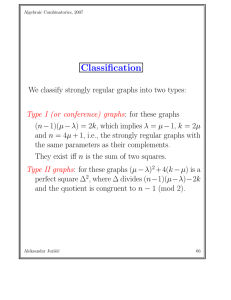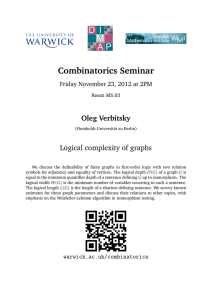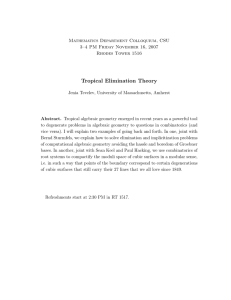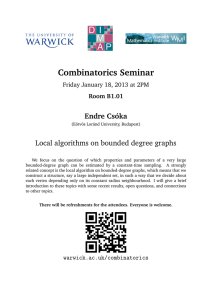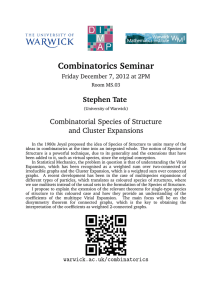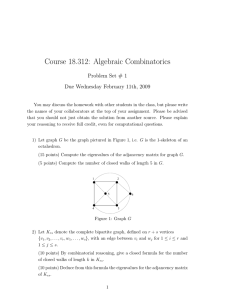III. Strongly regular graphs
advertisement
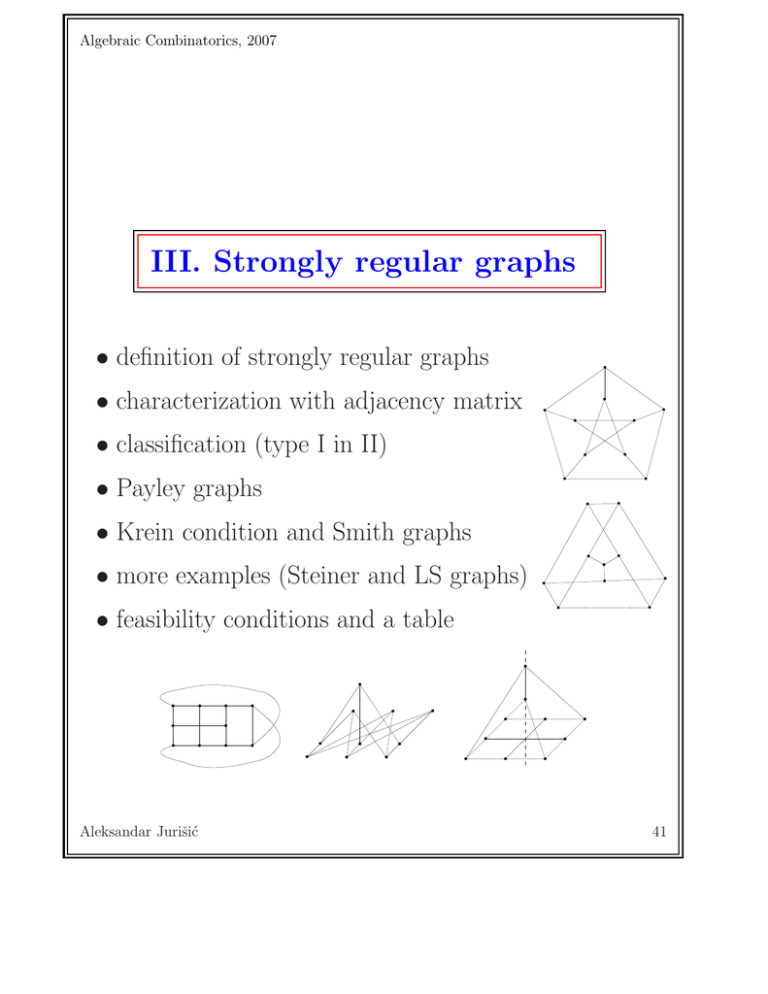
Algebraic Combinatorics, 2007
III. Strongly regular graphs
• definition of strongly regular graphs
• characterization with adjacency matrix
• classification (type I in II)
• Payley graphs
• Krein condition and Smith graphs
• more examples (Steiner and LS graphs)
• feasibility conditions and a table
Aleksandar Jurišić
41
Algebraic Combinatorics, 2007
Definition
Two similar regularity conditions are:
(a) any two adjacent vertices have exactly λ common
neighbours,
(b) any two nonadjacent vertices have exactly µ common
neighbours.
A regular graph is called strongly regular when it
satisfies (a) and (b).
Notation SRG(n, k, λ, µ),
where k is the valency of Γ and n = |V Γ|.
Strongly regular graphs can also be treated as extremal
graphs and have been studied extensively.
Aleksandar Jurišić
42
Algebraic Combinatorics, 2007
Examples
5-cycle is SRG(5, 2, 0, 1),
the Petersen graph is SRG(10, 3, 0, 1).
What are the trivial examples?
Kn,
m · Kn,
The Cocktail Party graph C(n), i.e., the graph
on 2n vertices of degree 2n−2, is also strongly regular.
Aleksandar Jurišić
43
Algebraic Combinatorics, 2007
Lemma. A strongly regular graph Γ is disconnected
iff µ = 0.
If µ = 0, then each component of Γ is isomorphic to
Kk+1 and we have λ = k − 1.
Corollary. A complete multipartite graph is
strongly regular iff its complement is
a union of complete graphs of equal size.
Homework: Determine all SRG with µ = k.
Aleksandar Jurišić
44
Algebraic Combinatorics, 2007
Counting the edges between the neighbours and nonneighbours of a vertex in a connected strongly regular
graph we obtain:
µ(n − 1 − k) = k(k − λ − 1),
i.e.,
k(k − λ − 1)
n=1+k+
.
µ
Lemma. The complement of SRG(n, k, λ, µ) is
again strongly regular graph:
SRG(n, k, λ, µ) = (n, n−k−1, n−2k+µ−2, n−2k+λ).
Aleksandar Jurišić
45
Algebraic Combinatorics, 2007
Let J be the all-one matrix of dim. (n × n).
A graph Γ on n vertices is strongly regular if and only
if its adjacency matrix A satisfies
A2 = kI + λA + µ(J − I − A),
for some integers k, λ and µ.
Therefore, the valency k is an eigenvalue with
multiplicity 1 and the nontrivial eigenvalues, denoted
by σ and τ , are the roots of
x2 − (λ − µ)x + (µ − k) = 0,
and hence λ − µ = σ + τ , µ − k = στ .
Aleksandar Jurišić
46
Algebraic Combinatorics, 2007
Theorem. A connected regular graph with
precisely three eigenvalues is strongly regular.
Proof. Consider the following matrix polynomial:
(A − σ)(A − τ )
M :=
(k − σ)(k − τ )
If A = A(Γ), where Γ is a connected k-regular graph
with eigenvalues k, σ and τ , then all the eigenvalues of
M are 0 or 1. But all the eigenvectors corresponding
to σ and τ lie in Ker(A), so rankM =1 and M j = j,
1
hence M = J. and A2 ∈ span{I, J, A}.
n
Aleksandar Jurišić
47
Algebraic Combinatorics, 2007
For a connected graph, i.e., µ 6= 0, we have
(k−σ)(k−τ )
n=
, λ = k+σ+τ +στ, µ = k+στ
k + στ
and the multiplicities of σ and τ are
mσ =
(n−1)τ + k (τ + 1)k(k − τ )
=
τ −σ
µ(τ − σ)
and mτ = n − 1 − mσ .
Aleksandar Jurišić
48
Algebraic Combinatorics, 2007
Multiplicities
Solve the system:
1 + mσ + mτ = n
1 · k + mσ · σ + mτ · τ = 0.
to obtain
1
(n − 1)(µ − λ) − 2k .
mσ and mτ = n − 1 ± p
2
2
(µ − λ) + 4(k − µ)
Aleksandar Jurišić
49
